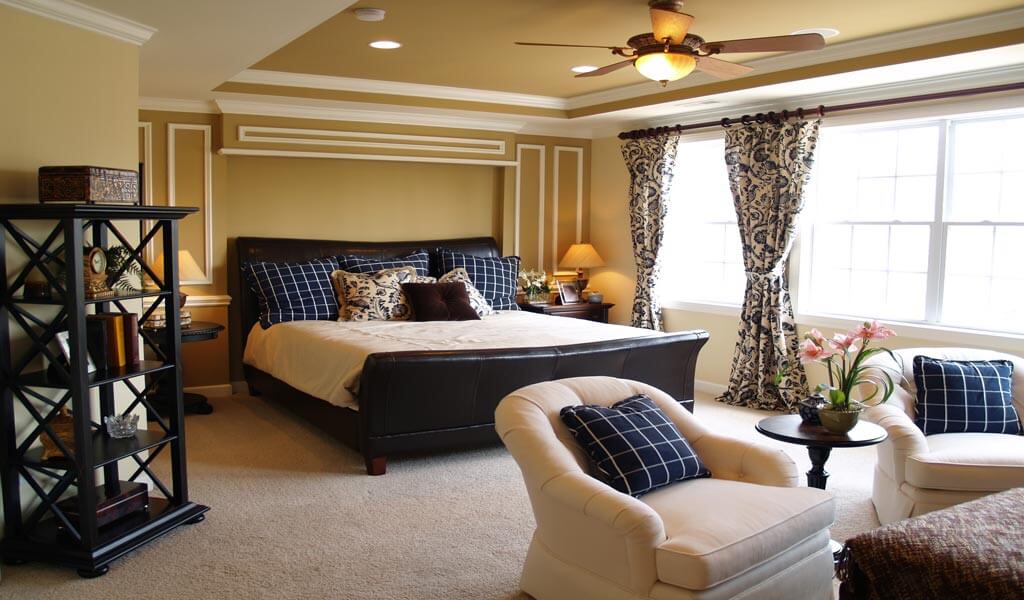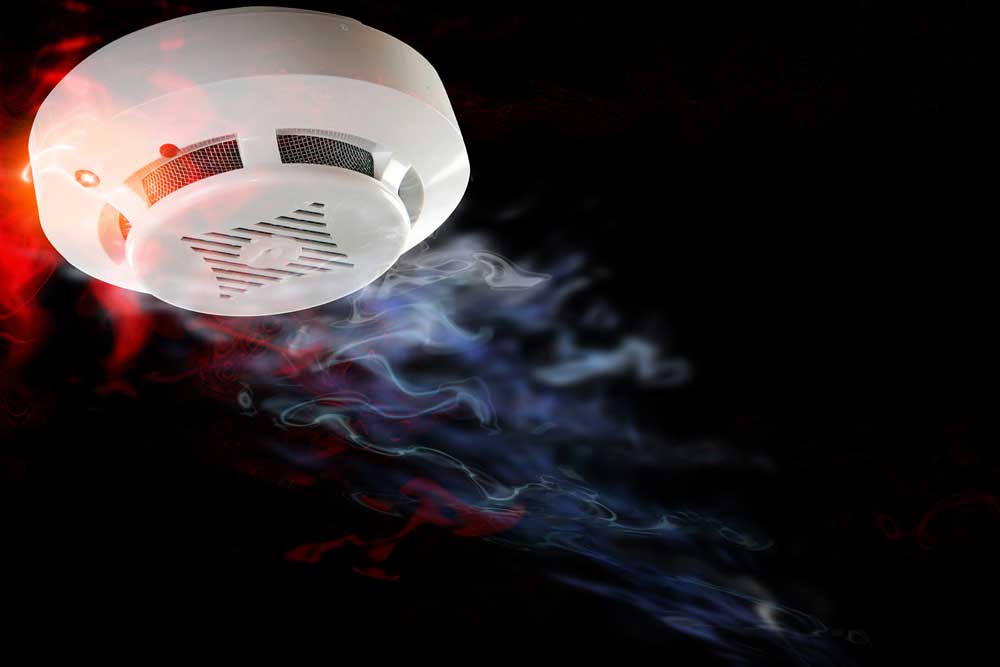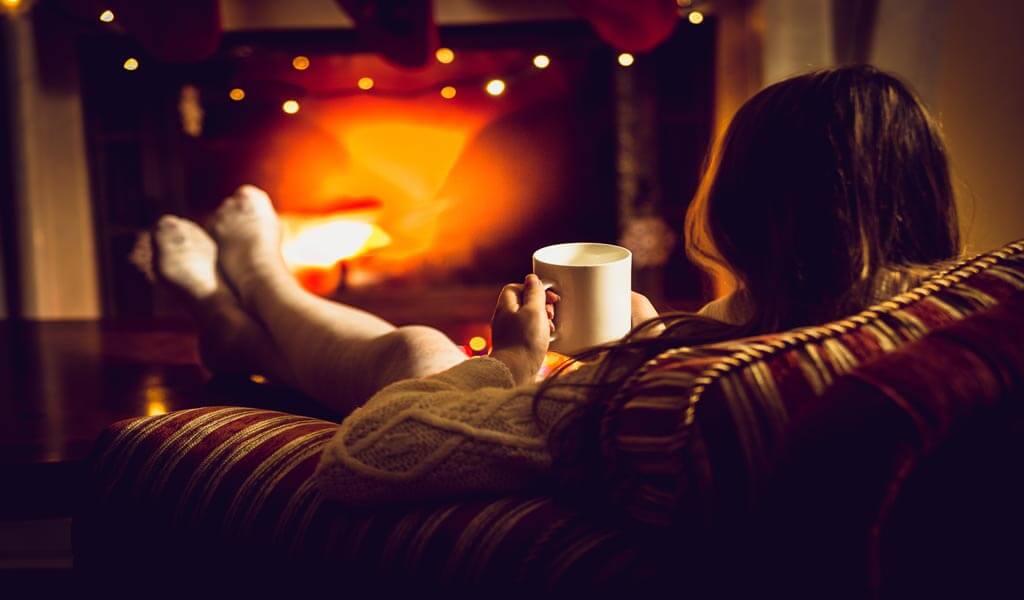When the leaves change colors, it’s time to think about preparing your home for winter. Taking these fifteen steps will keep you warm, safe, and save you money on winter heating costs.

1. Change ceiling fan direction
Did you know your ceiling fan should turn one way in the summer and another in the winter? According to the Department of Energy, ceiling fan performance and energy savings depend on the proper use of the fan.
In the winter, run the fan clockwise at a low speed. That creates an updraft, so the warm air that rose to the ceiling is naturally forced down toward you to keep you warm.
2. Program your thermostat
While fall is known for big temperature swings, once the cold weather arrives it’s time to program your thermostat. If you don’t have a programmable thermostat, buy one. It saves you money.
The Department of Energy estimates homeowners save as much as 10-percent on heating and cooling costs by programming their thermostat. To achieve these savings, set it back 7 to 10 degrees for 8 hours a day. Typically, while you’re at work.
The recommendation for the winter is 68-degrees while you’re awake and 7 to 10 degrees less while you’re asleep or away from home. If that’s too low for you, make adjustments based on your family’s comfort.
Programming your thermostat is an easy way to save money on your winter and summer heating and cooling costs.
3. Annual furnace inspection
You depend on your furnace a lot during the winter, so have it serviced in the fall. During a furnace inspection, an HVAC technician cleans, inspects, and fine-tunes your HVAC equipment.
It’s a checkup for your heating system. It prevents costly and uncomfortable breakdowns.
Who wants to come home to no heat in the middle of the winter? Plus, a furnace inspection keeps your unit running more efficiently which reduces utility bills, and protects the life of your HVAC equipment.
Your furnace works hard during the winter, sometimes running nonstop. That’s why it’s important to keep it running at its best with a furnace inspection.
4. Change your air filter
HVAC air filters remove pollutants and particles from the air, but over time dirt clogs the filter. Change your air filter to improve indoor air quality in your Kansas City home.
Air filters also keep your HVAC system running more efficiently, because it’s easier for air to pass through the filter when it’s clean.
5. Fireplace and chimney inspection
If you use your fireplace to warm your home, have a trained chimney inspector check and clean it. While a fireplace offers a cozy retreat during the winter, it can be dangerous if not properly inspected and checked each year.
Chimney maintenance protects you from chimney fires and carbon monoxide poisoning. Sometimes fires occur, and the homeowner doesn’t even know it.
A chimney sweep will check for signs of fire, damper issues, and cracks in the fireplace.
The Chimney Safety Institute of America recommends at least an inspection of your chimney’s structure and flue. That’s all you usually need if you lived in the home the previous winter.
If you just bought a home, get an inspection to make sure your chimney is safe. Even if your home inspector examined it before you purchased the house, you should consider hiring a chimney expert before winter. A chimney expert specializes in the mechanics of a fireplace and chimney more than a home inspector whose focus is on the entire home.
Hire a Certified Chimney Sweep by looking for the “CSIA Certified” logo. It’s the only nationally recognized chimney service accreditation.
Some companies say they’re certified even though they’re not. Don’t take a company’s word for it. Check the company’s certification with CSIA.
6. Close the damper
Once your fireplace is safe, close the damper, so you stay warm. Hot and cold air travels up the chimney when the damper is left open.
Close it after use.
7. Get a chimney cap
While your chimney sweep is at your home, he may recommend a chimney cap. It’s something you definitely should consider if you don’t use your fireplace, and its only purpose is decoration. The cap keeps outside elements and animals from getting inside.
When the temperatures drop, critters look for a warm place to hide. It’s common for raccoons, birds, and other animals to climb into your chimney. You realize there’s a problem when you hear them moving around inside or they come crashing down!
8. Check your carbon monoxide detector
Carbon monoxide is an odorless, poisonous gas. It’s a concern all year round, but especially in the winter when you’re indoors more, and you’re using your heat and fireplace.
If you don’t have a carbon monoxide detector, buy one. Your family’s life is worth the 20 dollars to get one.
More than 150 people die each year from carbon monoxide poisoning, according to the Consumer Product Safety Commission.
Second, check to see if it’s expired. Carbon monoxide detectors typically last 5-10 years, depending on when you bought it. The newer technology works for up to 10 years. You should replace them, even if they still work after they expire. Look for a date stamp on the back. You need the detector to keep you safe!
Since 2009, Underwriters Laboratories required CO2 manufactures include end-of-life warnings on detectors. Some brands started that practice long before the requirement.
Even with the end-of-life warning built it, one alarm manufacturer recommends you replace it before the warning sounds.
Take a minute and look on the back of your carbon monoxide detector for the expiration date. It truly saves lives!

9. Change your smoke detector batteries
Fall means daylight savings time. When you turn your clocks back, change your smoke detector batteries.
Fires are deadly every time of year, but the chance of fire increases in the winter when you’re spending more time inside, running your heat, and your fireplace.
10. Check the type of smoke detectors
Ninety-percent of homes have only one type of smoke detector. You should have two types, for maximum protection.
Smoke detectors have an “I” for ionization or a “P” for photoelectric. You want both types in your home, yet 90-percent of homes only have ionization alarms. If you don’t see mention of either, look for “radiation.” That means you have an ionization alarm.
Some counties throughout the United States, require photoelectric alarms. The World Fire Safety Foundation believes photoelectric is best!
Photoelectric alarms detect smoky and smoldering fires faster, which happen in more homes with the rise of synthetic products. The difference is several minutes, depending on the test. It’s enough to make a difference between life and death.
Ionization smoke detectors sense fast-moving fires.
You can buy ionization, photoelectric, or dual smoke detectors.
11. Check indoor and outdoor plumbing
In Kansas City, there’s usually a cold spell that freezes pipes causing costly repairs!
That’s why you should check indoor and outdoor plumbing before winter.
Disconnect outdoor houses, and if possible turn off the water outside.
When extreme cold sets in, open your cabinets so warm air reaches pipes under the sink. Believe it or not, kitchen pipes often freeze when the temperature plummets! You may also look into insulating the pipes, especially if they’re prone to freezing.
12. Winterize your irrigation system
Your irrigation system keeps your grass green all summer, but you don’t want water in the lines when the ground begins to freeze. It will cause costly repairs next spring.
You can winterize your irrigation system, or hire a sprinkler company to blow the water out of your sprinkler lines.
13. Prepare for an ice storm
Kansas City is prone to ice storms, sometimes leaving residents without power for an extended period. Prepare for power outages by gathering an emergency kit. Put flashlights in the kit with fresh batteries, lanterns, candles, matches, blankets, and some food. Keep it nearby in case of a winter storm.
14. Winterize the interior of your home
A bottle of caulk or air sealing foam goes a long way toward keeping the cold air out during the winter. Add caulk around drafty windows.
Also, add weather stripping along doorways to keep the warm air inside.
15. Insulation & energy audits
If your home is drafty, or rooms are too hot and others too cold, ask your HVAC company about an energy audit.
Heating and cooling rebates are often available to offset the costs of energy efficient improvements.
Kansas City Power & Light (KCP&L) offers rebates for saving energy with home improvements. That includes upgrading HVAC equipment, air sealing, and insulation. To qualify for some incentives, you may need an energy audit first.
An energy audit uses specialized equipment to detect areas of energy loss in your home.
Prepare for winter
You either love winter or hate it! Either way, it’s a reality for Kansas City homeowners. Prepare for winter in the fall, with these 15 steps. You’ll pay less for winter heating bills and feel warmer in your home.





 3751 NE Ralph Powell Road
3751 NE Ralph Powell Road 

